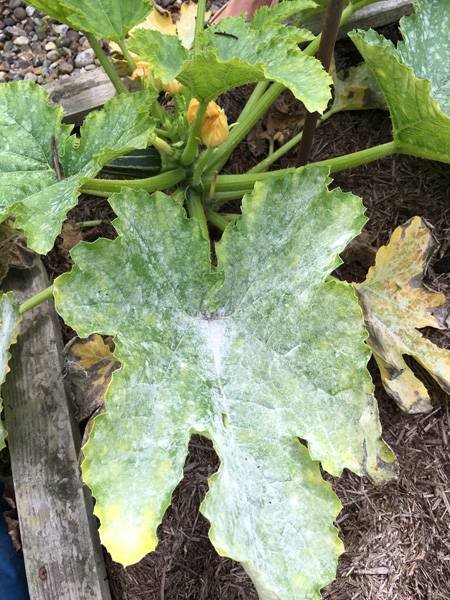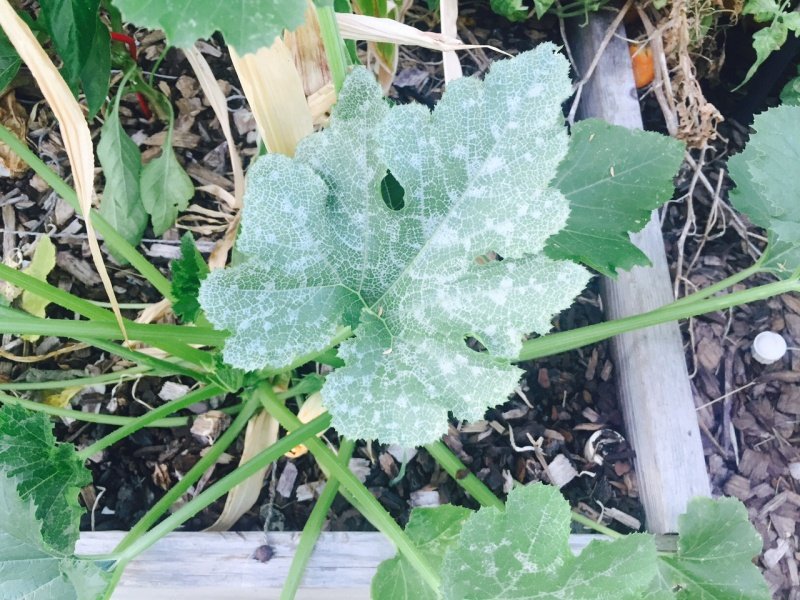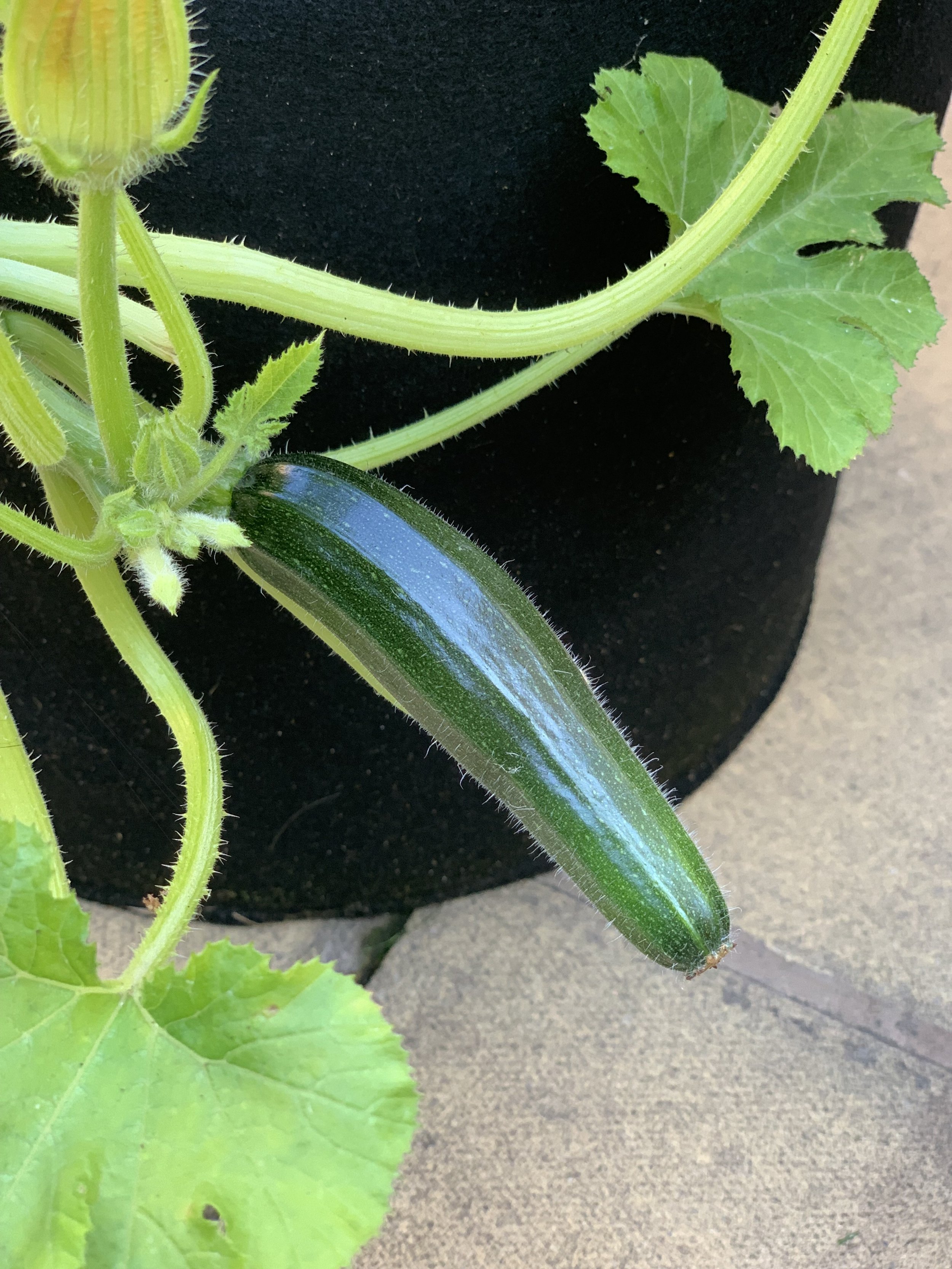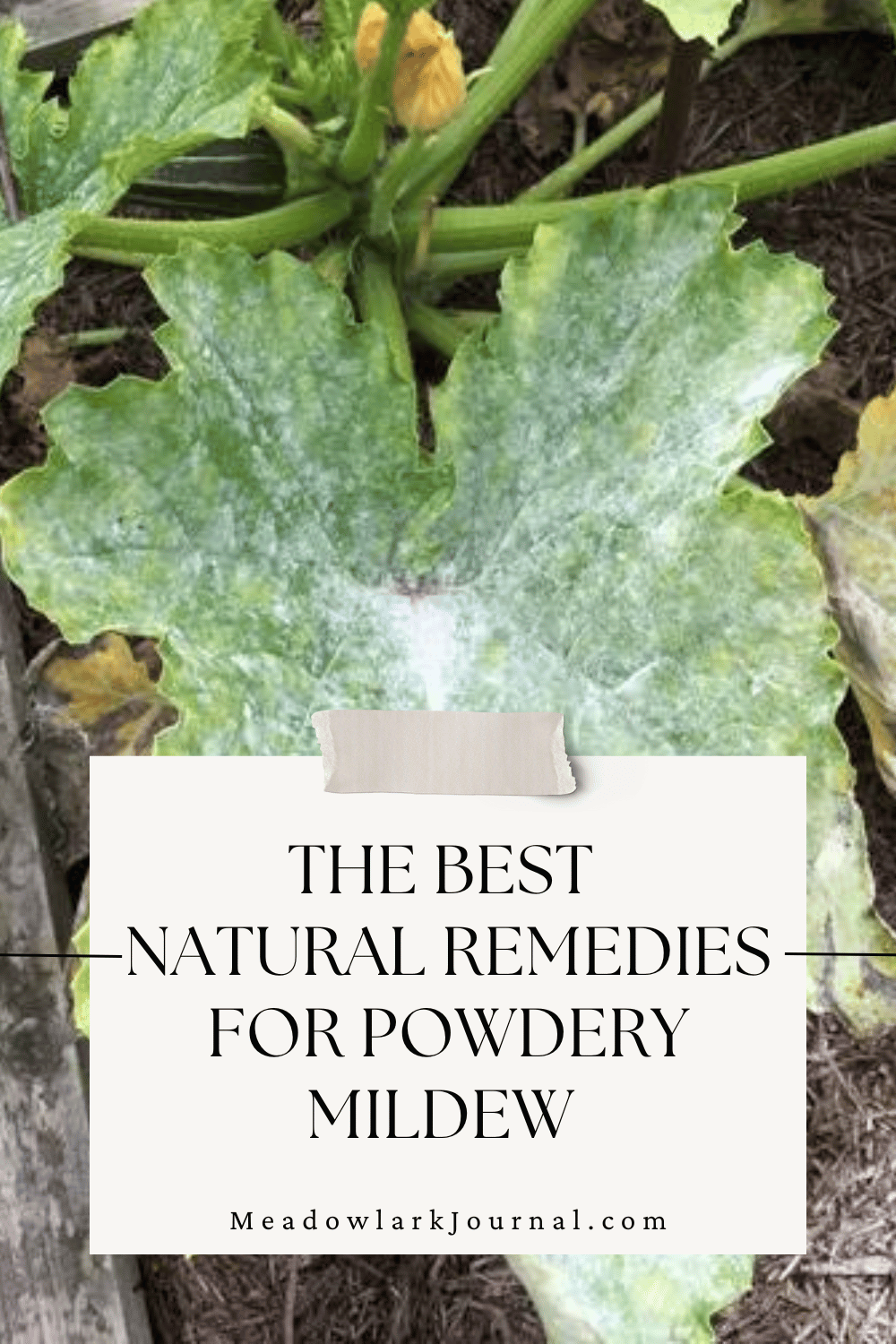Powdery Mildew on Zucchini: The Best Natural Remedies
This website is reader-supported - thank you! This post may contain affiliate links. As an Amazon Associate, I earn from qualifying purchases at no extra cost to you.
If you've noticed a ghostly white coating appearing on your zucchini leaves, you're likely dealing with powdery mildew.
This common fungal disease can quickly become a gardener's nightmare, spreading rapidly and weakening plants.
But fear not!
With some know-how and the right strategies, you can protect your zucchini from this pesky problem.
As any gardener knows, the joy of watching zucchini and other squash plants thrive in the summer garden is often tempered by the vigilance required to keep plant diseases at bay.
One of the most common and frustrating issues that gardeners face is powdery mildew, a fungal disease that manifests as a ghostly white coating on the leaves of plants.
This affliction not only detracts from the visual appeal of your garden but can also significantly impact the health and productivity of your plants.
Powdery mildew on zucchini is particularly troublesome during the warm, humid months of July and August when the conditions are ripe for fungal growth.
The disease spreads quickly and can leave gardeners feeling helpless as they watch their once-lush zucchini leaves become mottled with white spots.
However, with the right knowledge and tools at your disposal, you can effectively manage this condition and protect your garden.
This guide is designed to arm you with essential information and practical tips on how to prevent powdery mildew from taking hold, natural remedies for treating it, and strategies for managing infected plants.
By integrating proactive care and timely interventions, you can keep your zucchini plants healthy and ensure they continue to produce bountifully throughout the season.
Learn more about growing zucchini with my guide:
Understanding Powdery Mildew
Powdery mildew is a widespread fungal disease that affects a variety of plants, including the beloved zucchini.
Caused by different species of fungi in the Erysiphales order, it's easily recognizable by its distinctive white, powdery coating that can cover leaves, stems, and sometimes fruit.
Lifecycle and Development
Powdery mildew fungi are unique among plant pathogens because they do not require water to infect plants.
Instead, they thrive in dry conditions with high humidity.
The lifecycle begins with spores (conidia) that spread through the air and land on plant surfaces.
These spores germinate on the surface, sending out structures called haustoria into the epidermal cells of the host plant to extract nutrients.
As the disease progresses, the powdery mildew forms a mat of fungal growth that covers the plant's surface, which can lead to a decrease in photosynthesis, weakening the plant overall.
Over time, if unchecked, the fungus can cause leaves to yellow and die prematurely, which can severely affect the growth and yield of zucchini plants.
Symptoms and Signs
The first sign of powdery mildew on zucchini plants typically appears as small, powdery white spots on the upper surfaces of the leaves.
These spots can expand, eventually covering most of the leaf surface with a dusty, white to gray coating.
As the infection worsens, the leaves may turn yellow or brown and curl up or become distorted.
Besides the visible symptoms on leaves, powdery mildew can also affect the stems and flowers of zucchini plants, leading to weakened stems or reduced flowering, which impacts fruit production.
Environmental Factors
Certain conditions can exacerbate the spread and severity of powdery mildew:
Temperature and Humidity:
Temperatures between 60-80°F (15-27°C) coupled with high ambient humidity are ideal for spore germination and growth.
Shade and Air Circulation:
Poor air circulation and shaded conditions favor the development of powdery mildew.
Zucchini plants that are too closely spaced or grown in shaded areas are more susceptible to infection.
To learn more about avoiding powdery mildew, check out my guide:
Powdery Mildew Prevention Strategies
Preventing powdery mildew involves a combination of practices, careful selection of plant varieties, and environmental control.
Here’s how you can keep this fungal menace at bay:
Select Resistant Varieties
One of the most effective ways to prevent powdery mildew is to start with resistant varieties.
Plant breeders have developed several zucchini cultivars that are less susceptible to powdery mildew.
These varieties have genetic traits that either reduce the likelihood of infection or limit the severity of the disease's impact on the plant.
When purchasing seeds or seedlings, look for labels that mention resistance to powdery mildew.
Here are my recommended resistant varieties:
Green Machine
This hybrid is noted for its exceptional disease resistance, including against powdery mildew, and produces rich green fruits consistently throughout the season.
Here are the seeds I recommend:
Gold Rush
A popular yellow zucchini variety that is not only eye-catching but also has a reputation for good resistance to powdery mildew, making it a favorite if you like a splash of color in the kitchen garden.
Here are the seeds I recommend:
Optimal Plant Spacing and Site Selection
Proper spacing between plants is crucial for preventing many types of fungal diseases, including powdery mildew.
Adequate space ensures good air circulation around the plants, which helps keep the foliage dry and less hospitable to spores that thrive in humid conditions.
Sunlight Exposure:
Choose a planting site that receives full sunlight for at least 6-8 hours a day, such as a south-facing or west-facing garden location.
Sunlight not only promotes strong plant growth but also helps minimize the moisture on plant surfaces, reducing the risk of fungal development.
Air Circulation:
Avoid overcrowding by spacing zucchini plants according to the recommendations for the specific variety.
This spacing helps maximize air flow, which is essential for keeping the leaves dry and less favorable for fungal growth.
Proper Watering Techniques
How and when you water your plants can significantly influence the development of powdery mildew:
Water Early in the Day:
Watering early allows the leaves and soil surface to dry out over the course of the day, decreasing the likelihood of fungal spores finding the moist conditions they need to thrive.
Avoid Overhead Watering:
Use soaker hoses or drip irrigation to deliver water directly to the soil, avoiding wetting the leaves.
Keeping the foliage dry is key in preventing powdery mildew.
Here is the soaker hose I recommend for watering zucchini:
For more watering tips, check out my guide: Water Butts: Sustainable Water Storage for Your Garden.
Maintain Nutrient Balance
Ensuring your zucchini plants are not only well-fed but correctly fed can influence their susceptibility to disease:
Avoid Excessive Nitrogen:
High levels of nitrogen can encourage lush foliage growth, which is more susceptible to fungal diseases.
Balance your fertilizer application according to the needs of your plants, focusing on a well-rounded nutrient mix that supports overall plant health.
Here is the fertilizer I recommend for zucchini:
Regular Inspection and Cleanliness
Frequent monitoring of your plants can catch powdery mildew early, before it spreads significantly.
Inspect your plants regularly for the first signs of the disease, and take immediate action if you see any symptoms.
Garden Hygiene:
Remove plant debris and fallen leaves from the garden.
Clean up at the end of the growing season to reduce overwintering sites for fungal spores.
Disinfect Tools:
After working with infected plants, clean and disinfect your garden tools to prevent the spread of spores to healthy areas of your garden.
For more vegetable garden tips, check out my guide: The Best Compost for Vegetable Gardens.
Natural Remedies for Powdery Mildew on Zucchini
When prevention falls short, or if you spot the early signs of powdery mildew, there are several effective, environmentally friendly treatments you can use.
These methods help manage the disease without resorting to harsh chemicals, making them safe for your garden.
Baking Soda Solution
One of the simplest and most commonly used treatments for powdery mildew is a baking soda spray.
Baking soda helps raise the pH on the leaf surface, making it less hospitable for the fungi.
Recipe:
Mix 1 tablespoon of baking soda with 1/2 tablespoon of liquid, non-detergent soap and 1 gallon of water.
Shake well and spray generously on the plant, covering all affected areas completely.
This solution can be used once a week and after rainfalls.
Neem Oil
Neem oil is a natural fungicide and insecticide derived from the seeds of the neem tree.
It's effective against powdery mildew and can also help control other pests.
Application:
Mix neem oil as directed on the product label—usually a couple of teaspoons per gallon of water.
Add a few drops of liquid soap to help the oil blend with water.
Spray the mixture on both sides of the zucchini leaves, preferably in the evening or when the plant is not in direct sunlight.
Here is the neem oil I recommend:
Milk Spray
Milk is another effective, surprising remedy against powdery mildew.
Theories suggest that proteins in the milk, when exposed to the sun, produce antiseptic substances that may combat the mildew.
Recipe:
Mix 40% milk and 60% water.
Spray the plants with this solution every 10 days.
It can be particularly effective as a preventative measure and is safe to use throughout the season.
Garlic Extract
Garlic has natural fungicidal properties that can help control powdery mildew.
Using a garlic spray not only helps treat powdery mildew but can also deter pests.
Preparation:
Blend two cloves of garlic with a couple of cups of water, strain, and add to a gallon of water with a teaspoon of liquid soap.
Spray this on affected areas every few days until the mildew subsides.
Vinegar Solution
Vinegar, containing acetic acid, can act as a fungicide.
However, it should be used with caution as it can burn plants if not diluted properly.
Recipe:
Mix 2 tablespoons of apple cider vinegar with a gallon of water.
Spray the solution on affected plants once a week.
Avoid applying in direct sunlight to prevent leaf burn.
Usage and Precautions
While natural remedies are less harmful than synthetic chemicals, they still require careful application:
Test on a Small Area:
Before applying any new treatment, test it on a small part of the plant to see how it reacts.
Avoid Overuse:
Overuse of any treatment, natural or not, can cause damage to plants or lead to resistant strains of fungi.
Monitor and Adjust:
Observe how your plants respond to treatments and adjust your approach if necessary.
For more vegetable garden tips, check out my guide: Top 10 Flowers to Plant in Your Vegetable Garden.
Managing Infected Plants
Once your zucchini plants show signs of powdery mildew, prompt and effective management is key to controlling the outbreak and minimizing damage to your garden.
Here are some strategies to adopt:
Removing Infected Plant Parts
One of the first steps in managing an outbreak of powdery mildew is to physically remove the affected plant parts.
This can help reduce the number of fungal spores that could spread to healthy tissue.
Prune Carefully:
Using clean, sharp scissors or pruning shears, remove any leaves or stems that show signs of powdery mildew.
It’s crucial to clean your tools after each cut to avoid spreading the disease further.
These pruning shears are perfect for the job:
Dispose Properly:
Do not compost the infected plant material as powdery mildew spores can survive in compost and spread later.
Instead, seal the affected debris in a bag and dispose of it with household waste.
Enhancing Plant Conditions
Improving the environmental conditions around your plants can significantly help control and prevent the spread of powdery mildew.
Increase Air Circulation:
If your plants are too close to each other, consider thinning them out.
More space between plants allows better air flow and reduces the humidity around the foliage, making conditions less favorable for mildew development.
Adjust Watering Practices:
Ensure that you water the plants at the base to avoid wetting the foliage.
Early morning watering is ideal as it gives the plants time to dry out during the day.
For more watering tips, check out my guide: How to Use Watering Globes.
Monitoring and Follow-Up
Continuously monitoring your plants after initial treatments is crucial for managing powdery mildew effectively.
Regular Inspections:
Check your plants regularly for signs of new infection or recurring symptoms.
Early detection means easier control.
For more tips, check out my guide: Top Slug Resistant Plants to Transform Your Garden
Long-Term Management and Care
Here’s how you can keep your zucchini plants thriving and minimize the risk of powdery mildew and other diseases:
Regular Monitoring and Early Detection
Long-term management starts with vigilance.
Regularly inspecting your plants allows you to catch any signs of disease, pests, or nutritional deficiencies early, when they are easiest to address.
Routine Checks:
Schedule weekly inspections of your zucchini plants to look for signs of stress, disease, or insect damage.
Pay special attention to the undersides of leaves where problems often start unnoticed.
Record Keeping:
Keep a garden journal to note any issues, treatments applied, and how the plants responded.
This information can be invaluable for managing future growing seasons more effectively.
For more recommended garden journal, check out my guide The Best Gifts for Gardeners.
Cultural Practices for Disease Prevention
Maintaining a healthy garden environment is critical for disease prevention.
This includes several practices that promote vigorous plant growth and reduce disease.
Crop Rotation:
Avoid planting zucchini or other squash family plants in the same location year after year.
Rotating crops helps prevent soil-borne diseases and pests from becoming established.
Soil Health:
Maintain soil fertility by adding organic matter such as compost and using cover crops in the off-season.
Healthy soil supports strong plant growth with better disease resistance.
For an easy way to enrich your soil, check out my guide: A Simple Recipe for Rich Compost Tea.
Proper Fertilization:
Use a balanced fertilizer to encourage healthy growth.
Excessive nitrogen can promote lush foliage that is more susceptible to powdery mildew, so it’s important to follow recommended rates based on soil tests.
Here is the fertilizer I recommend using:
Environmental Control
Controlling the environment around your zucchini plants can significantly reduce the occurrence of diseases like powdery mildew.
Optimize Plant Spacing:
As your zucchini plants grow, ensure they have enough space to promote good air circulation.
This helps leaves dry quickly and reduces the humidity that promotes fungal growth.
Mulching:
Apply a layer of organic mulch around the plants.
Mulch helps regulate soil moisture and temperature, suppresses weeds, and reduces spore splash-up from the soil.
To learn more about mulch, check out my guide: The Best Alternatives to Traditional Mulch for Your Garden.
Managing Plant Stress
Plants under stress are more susceptible to diseases and pests.
Managing stress involves several ongoing care practices.
Water Management:
Ensure plants receive consistent, adequate watering.
Drought stress can weaken plants and make them more susceptible to disease.
Shade and Sun Exposure:
While zucchini plants need full sun, during extremely hot weather, temporary shade solutions can prevent overheating and reduce stress.
Here is the shade cloth I recommend:
For more vegetable garden tips, check out my guide: What to Put on the Bottom of a Raised Garden Bed.
FAQs
Is it safe to eat zucchini with powdery mildew?
Yes, zucchini with powdery mildew can still be eaten, provided that the affected parts are removed before consumption.
It’s important to thoroughly wash the zucchini to remove any fungal residue.
However, severely affected fruits might have a compromised flavor and texture, making them less desirable for eating.
Should I cut off leaves with powdery mildew?
Yes, removing leaves that show signs of powdery mildew is generally recommended to help control the spread of the disease.
Be sure to:
Cut carefully:
Use clean, sterilized pruning tools to cut the affected leaves.
Disinfect the tools after each use to prevent spreading the disease.
Dispose properly:
Do not compost the removed leaves as the spores can survive and spread the infection later.
Instead, seal them in a plastic bag and dispose of them in the trash.
For more tips, check out my guide: The Best Gardening Books for Beginners.
As we journey through the gardening months of July and August, the fight against plant diseases like powdery mildew becomes a pivotal aspect of caring for zucchini and other squash plants.
Whether you're tending to your plants in a sprawling garden or a neatly organized raised bed, understanding how to prevent and manage powdery mildew is crucial for ensuring a healthy and productive harvest.
Regularly inspecting your plants and using your spray bottle filled with homemade fungicidal solutions can make a significant difference in controlling this pervasive disease.
Pay special attention to any infected leaves, removing them promptly to prevent the spread of the disease to the rest of your plant.
Maintaining diligent care, adopting preventive measures early in the season, and being prepared to act quickly if you spot the telltale powdery residue can keep your squash plants thriving.
With these strategies in place, you can enjoy the fruits of your labor, free from the worries of powdery mildew, throughout the growing season.
Pin this post to save it for later!












































